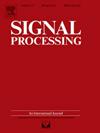On adaptive multichannel dereverberation based on dichotomous coordinate descent and data-reuse techniques
IF 3.4
2区 工程技术
Q2 ENGINEERING, ELECTRICAL & ELECTRONIC
引用次数: 0
Abstract
Multichannel linear prediction (MCLP) is widely used for speech dereverberation, with recursive least-squares (RLS)-like algorithms commonly applied to update the linear prediction coefficients. However, these algorithms tend to be computationally intensive, making it necessary in practical implementations to reduce complexity while improving numerical robustness for better dereverberation performance. In this paper, we introduce a more efficient MCLP-based adaptive dereverberation method that combines dichotomous coordinate descent (DCD) with a data-reuse (DR) technique. Compared to the traditional RLS-based approach, the proposed method offers two major benefits. First, it significantly lowers computational demands by replacing most multiplications with bitshifts during DCD iterations, making it more suitable for real-world applications. Second, by avoiding the propagation of the inverse covariance matrix via the Riccati equation, the method ensures numerical stability, making it more suitable for processing long-duration speech signals. Additionally, the DR technique improves dereverberation performance by more efficiently utilizing available observed data. Simulation results show that the proposed methods outperform the conventional RLS-based approach in terms of both numerical stability and computational efficiency, while delivering comparable dereverberation performance.
基于二分类坐标下降和数据复用技术的自适应多信道去噪
多通道线性预测(MCLP)广泛用于语音去噪,通常采用递推最小二乘(RLS)算法来更新线性预测系数。然而,这些算法往往是计算密集型的,因此在实际实现中有必要降低复杂性,同时提高数值鲁棒性以获得更好的去噪性能。本文介绍了一种更有效的基于mclp的自适应去噪方法,该方法将二分类坐标下降(DCD)与数据重用(DR)技术相结合。与传统的基于rls的方法相比,该方法具有两个主要优点。首先,通过在DCD迭代期间用位移替换大多数乘法,它显著降低了计算需求,使其更适合实际应用程序。其次,该方法避免了通过Riccati方程传播协方差逆矩阵,保证了数值稳定性,更适合处理长时间语音信号。此外,DR技术通过更有效地利用现有观测数据来提高去噪性能。仿真结果表明,该方法在数值稳定性和计算效率方面都优于传统的基于rls的方法,同时具有相当的去噪性能。
本文章由计算机程序翻译,如有差异,请以英文原文为准。
求助全文
约1分钟内获得全文
求助全文
来源期刊

Signal Processing
工程技术-工程:电子与电气
CiteScore
9.20
自引率
9.10%
发文量
309
审稿时长
41 days
期刊介绍:
Signal Processing incorporates all aspects of the theory and practice of signal processing. It features original research work, tutorial and review articles, and accounts of practical developments. It is intended for a rapid dissemination of knowledge and experience to engineers and scientists working in the research, development or practical application of signal processing.
Subject areas covered by the journal include: Signal Theory; Stochastic Processes; Detection and Estimation; Spectral Analysis; Filtering; Signal Processing Systems; Software Developments; Image Processing; Pattern Recognition; Optical Signal Processing; Digital Signal Processing; Multi-dimensional Signal Processing; Communication Signal Processing; Biomedical Signal Processing; Geophysical and Astrophysical Signal Processing; Earth Resources Signal Processing; Acoustic and Vibration Signal Processing; Data Processing; Remote Sensing; Signal Processing Technology; Radar Signal Processing; Sonar Signal Processing; Industrial Applications; New Applications.
 求助内容:
求助内容: 应助结果提醒方式:
应助结果提醒方式:


